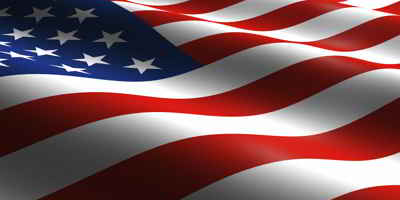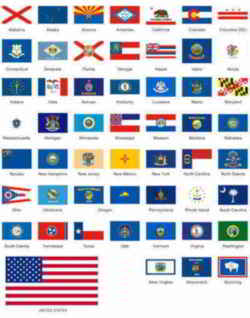

US Flag Etiquette

Etiquette for US Flag
Adopted on June 14, 1777
In 1942 a law was passed by the US Congress establishing specific rules for the display of the US flag by civilians or groups previously not subject to US governmental regulations. The intent of the law was to ensure that the US flag be given a position of honor.
Ceremonial | Inside | Government
Parades | Decorative | Flag Maintenance
When to Fly the Flag | Pledge of Allegiance
In a procession the US flag is carried on the military right of the column; in procession with other flags it is carried in front; with another flag on a wall, both flags with staffs, the US flag is to the right with the US flagstaff in front of the other; with other flags on the same halyard, the US flag is on top, although an exception is made when the church pennant of the services is flown from the same staff; with two or more flags in line, the US flag is at right; with a group of other flags on display where the bottoms of the staffs touch in fanlike fashion, the US flag is displayed in the center. Although the US flag is usually displayed from sunrise to sunset, through law or presidential proclamation it is flown both day and night at the following patriotic sites: Fort McHenry National Monument and Historical Shrine, Md.; Flag House Square, Baltimore, Md.; United States Marine Corps (Iwo Jima) Memorial, Va.; and Battle Green, Lexington, Mass.
The United States Flag Code stipulates that as the symbol of a living country, the flag is considered in itself a living thing and should be properly displayed and cared for. The code outlines the proper ways to display the American flag.
- Raise the flag briskly. Lower it ceremoniously.
- Never allow the flag to touch the ground or floor.
- Do not fly the flag in bad weather, unless it is an all-weather flag.
- The flag can only be flown at night if properly illuminated. Otherwise, it should only be flown from sunrise to sunset.
- The flag should always be allowed to fall free.
- The flag should never be used to carry, store, or deliver anything.
- Never fly the flag upside down except to signal an emergency.
Ceremonial

- When hung over a sidewalk on a rope extending from a building, the stars are always away from the building.
- When the flag is hung over a street running east to west, the stars are always toward the north. When the flag is hung over a street running north to south, the stars are always toward the east.
- When a group of flags is being displayed, the US flag should be at the center and at the highest point. The only exception is when the flag of another nation is being flown - national flags should be of the same size and fly at the same height.
- When covering a casket, the stars should be at the head and over the left shoulder. The flag should never touch the ground or be lowered into the grave.
Inside
- When on a speaker's podium, the flag should be either above and behind the speaker, or to the speaker's right as he faces the audience.
- When displayed either horizontally or vertically against a wall, the union (blue field) should be uppermost and to the flag's right, that is, the observer's left.
- In a window, or suspended above a corridor, the flag should hang with the union on the viewer's left.
Government
- The flag should be flown daily at the main administration building of public institutions.
- Polling places should display a flag on election days.
- School buildings should display a flag when school is in session.
- Flags should fly at half-mast on the deaths of certain government officials.
- When the flag is displayed against a wall with another flag from crossed staffs, the US flag should be on the right (facing the audience) and its staff should be on top of the other flag's.
Parades
- When the flag is carried in procession with other flags, it should be either on the right of the line of flags, or in front of the center of the line.
- On floats, the flag should be displayed on a staff.
- The flag should not be draped over a car, train, or boat. When displayed with a car, the flag's staff should be attached to the right fender, or the chassis.
- The flag should be held upright and should not be dipped to any person or thing. Regimental, state, or organizational flags may be dipped.
Decorative
- The flag should never be used as clothing, bedding, or drapery. Red, white, and blue bunting may be used as decoration instead, with the blue on top, white in the middle, and red below.
- The flag should never be part of a uniform, but a flag patch or lapel pin can be part of a police or other uniform.
- The flag should not be used to cover a statue or monument.
- The flag should not be used to cover a ceiling.
- Advertising banners should not be hung from the same staff as a flag.
- The flag should not appear on napkins, boxes, or other disposable items, nor should it be embroidered on cushions, handkerchiefs, or similar objects.
Flag Maintenance
-
For More See Flag Presentation
- The flag should never be carried flat or horizontally, but always aloft and free.
- Care should be taken not to let the flag get torn, dirty, or damaged.
- The flag should never have placed upon it, nor attached to it, any mark, insignia, letter, word, figure, design, picture, or drawing.
When to Fly the Flag
- The flag can be displayed on all days, but in particular it should be flown on:
- New Year's Day, January 1
- Inauguration Day, January 20
- Lincoln's Birthday, February 12
- Washington's Birthday, third Monday in February
- Easter Sunday (variable)
- Mother's Day, second Sunday in May
- Armed Forces Day, third Saturday in May
- Memorial Day (half-staff until noon), the last Monday in May
- Flag Day, June 14
- Independence Day, July 4
- Labor Day, first Monday in September
- Constitution Day, September 17
- Columbus Day, second Monday in October
- Navy Day, October 27
- Veterans Day, November 11
- Thanksgiving Day, fourth Thursday in November
- Christmas Day, December 25
- Other days as may be proclaimed by the President of the United States
- The birthdays of States (date of admission)
- State holidays
- On Memorial Day, the flag should be hung at half-staff until noon, when it should be raised to the top of the staff.
Pledge of Allegiance
"I pledge allegiance to the Flag of the United States of America, and to the Republic for which it stands, one Nation under God, indivisible, with liberty and justice for all."
The pledge should be said while standing at attention and facing the flag with right hand over the heart. When not in uniform men should remove their headdress with their right hand and hold it at the left shoulder, the hand being over the heart. Persons in uniform should remain silent, face the flag and render the military salute.
The same behavior applies during the raising or lowering of the flag, or when it passes on parade.

The Flags of the US.





